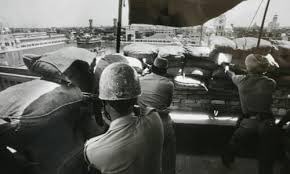3 June 1984 was observed as the Shaheedi Diwas (Martyrdom Day) of Sri Guru Arjan Dev Ji, the fifth Sikh Guru. Thousands of Sikh pilgrims from across Punjab, India and the world had gathered at Sri Darbar Sahib to pay obeisance and bathe in the holy Sarovar.
They had been allowed to enter freely by the Indian Army, who had surrounded the complex and had full knowledge of the destruction and devastation they were going to inflict upon these unarmed civilians in the coming days.
Most international journalists had been expelled from the city the day before, rounded up by the military and taken to Delhi on buses. The remaining domestic journalists were allowed to move in and out of the Darbar Sahib complex until the afternoon of June 3.
These journalists reported that there were more than ten thousand Sikh devotees, including countless women and children, inside the complex with no idea of the horrors that were about to be unleashed on them by the Indian state and its Army.
By nightfall, the Army had tightly sealed all routes of exit from Darbar Sahib. No one could freely exit the complex. At 9pm, a 36 hour statewide curfew was announced, confining Sikhs to their homes and completely trapping worshippers inside Darbar Sahib with no option to leave.
“Oppression in Punjab”, a report by Citizens for Democracy, found “they had been given no inkling or warning either of the sudden curfew or of the imminent Army attack. It was to be a blackhole tragedy, not out of forgetfulness but out of deliberate planning and design.”
On the evening of 3 June 1984, the Indian state handed over control of Punjab to its armed forces without due process, and in complete violation of constitutional law. The communication blackout that had been applied to Amritsar the day before was extended across all of Punjab.
All communications including phone lines to and from Punjab were cut. Roadblocks prevented anyone from entering or leaving the state and all remaining journalists were expelled from Punjab.
Once the curfew was imposed, without warning, the Army opened heavy fire
Once the curfew was imposed, without warning, the Army opened heavy fire
on the Darbar Sahib complex that continued until the early hours of 4 June.
Sant Jarnail Singh Ji Khalsa Bhindranwale and his followers gallantly defended Sikhs’ holiest of shrines throughout the night, preventing the Army from advancing into the complex itself.
Sant Jarnail Singh Ji Khalsa Bhindranwale and his followers gallantly defended Sikhs’ holiest of shrines throughout the night, preventing the Army from advancing into the complex itself.
On the same night, the Army surrounded and attacked 80+ other Gurudwaras across Punjab, proving that it was never about ‘militants’ at Darbar Sahib, but instead a deliberate strategy to crush a revolution, kill the spirit of the Sikh community and silence a civil rights movement.
At the Government Rajendra Hospital in Patiala, doctors reported that at least 56 Sikhs had been killed as a result of the Indian Army’s unprovoked attack on Gurudwara Dukh Niwaran Sahib in Patiala alone.
sikhsiyasat.net/new-book-docum…
sikhsiyasat.net/new-book-docum…
The Army had issued “shoot to kill” orders on 3 June 1984, but after Punjab Chief Secretary; KD Vasudeva and IG Intelligence; HS Randhawa protested the illegality of the orders they were withdrawn on the same day. Martial law had not been declared, in fact it was never declared.
This means the Army was outside of the law when they shot dead milk vendors for violating curfew. It also means that the military executions the Army carried out at Darbar Sahib & 80+ other Gurdwaras that night and the days that followed were war crimes of the most horrific kind.
• • •
Missing some Tweet in this thread? You can try to
force a refresh

 Read on Twitter
Read on Twitter









